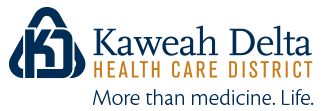

Summer is here and that means vacations, adventures, and fun in the sun. Unfortunately, it can also lead to unintentional accidents and injuries. Hi, this is Jody Jo.
Did you know uncontrolled bleeding is the number one cause of preventable death from trauma? The more people who know how to control bleeding in an injured patient, the greater the chance there is of surviving that injury. You may be able to save a life before help arrives by knowing the ABCs of how to stop a life threatening bleed.
A – Alert-call 911 and signal first responders to the scene.
B – Bleeding-find the source of bleeding and remove any clothing from the wound.
C – Compress-Cover the wound with a clean cloth and apply continuous, firm pressure with your hands.
It’s very important that we educate our community members about how they can stop the bleeding and save either themselves or someone else.
If you are interested in hosting a Stop the Bleed Seminar or Presentation, go to KaweahDelta.org
SPONSORED BY:
Be mindful of:
Sunburn
- Choose lightweight, light-colored, loose-fitting clothing.
- In the hot sun, a wide-brimmed hat will keep the head cool and sunglasses to shield the eyes.
- Sunburn affects your body\’s ability to cool itself and causes a loss of body fluids. It also causes pain and damages the skin. A variety of sunscreens are available to reduce the risk of sunburn. Check the sun protection factor (SPF) number on the label of the sunscreen container. Select SPF 15 or higher and follow package directions (SPF 30 or higher is recommended for children). Apply liberally and often.
- Try to stay out of the sun during peak hours, 10 am – 4 pm
- When outdoors, seek shade as often as possible.
Heat Stroke and Heat Exhaustion
Two common problems are heat stroke and heat exhaustion. Heat stroke occurs when the body becomes unable to control its temperature. The body\’s temperature rises rapidly, the sweating mechanism fails, and the body is unable to cool down. Body temperature may rise to 106°F or higher. Heat stroke can cause death or permanent disability if emergency treatment is not given. Heat exhaustion is the body\’s response to an excessive loss of water and salt contained in sweat. People most prone to heat exhaustion are the elderly and those working or exercising in a hot environment.
Warning signs of heat stroke vary but may include:
- An extremely high body temperature (above 103°F, orally)
- Unconsciousness
- Dizziness, nausea, and confusion
- Red, hot, and dry skin (no sweating)
- Rapid, strong pulse
- Throbbing headache
Warning signs of heat exhaustion vary but may include:
- Heavy sweating
- Muscle cramps
- Weakness
- Headache
- Nausea or vomiting
- Paleness, tiredness, and dizziness
What to Do
If you see any of these signs, you may be dealing with a life-threatening emergency. Have someone call for immediate medical assistance while you begin cooling the victim:
- Get the victim to a shady area.
- Cool the victim rapidly using whatever methods you can. For example, immerse the victim in a tub of cool water, place in a cool shower, spray with cool water from a garden hose, sponge with cool water, or if the humidity is low, wrap the victim in a cool, wet sheet and fan him or her vigorously.
- Monitor body temperature and continue cooling efforts until the body temperature drops to 101-102°F.
- If emergency medical personnel are delayed, call the hospital emergency room for further instructions.
- Do not give the victim alcohol to drink.
- Get medical assistance as soon as possible.
Dehydration
- Increase your fluid intake regardless of your activity level.
- During heavy exercise in hot weather, drink 2-4 glasses (16-32 ounces) of cool fluids each hour.
- During hot weather, you will need to drink more liquid than your thirst indicates. This is especially true for those over 65 years of age.
- Avoid very cold beverages to prevent stomach cramps or drinks containing alcohol, which will actually cause you to lose more fluid.
- Drinking water in instead of juice, sodas or sugary drinks is your best choice.
HELPFUL RESOURCES
Here are some helpful resources for more information:
Save A Life: What Everyone Should Know to Stop Bleeding






